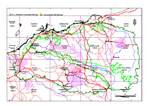Botanical name
Acacia hilliana x stellaticeps
Description
Low spreading, multi-stemmed, much-branched, more or less flat-topped or low-domed, glabrous shrubs 0.3-0.4 m tall and 1-2 m across, not noticeably aromatic. Bark grey. Branchlets obscurely tuberculate and obscurely ribbed. New shoots resinous, slightly to moderately sticky, the young phyllodes dark green and slightly shiny. Phyllodes solitary at nodes or occasionally in clusters of 2 or 3, flat, linear to narrowly oblong to slightly elliptic, 15-30 (-35) mm long, 1.5-3 mm wide, rather wide-spreading, straight or infrequently shallowly recurved, sometimes shallowly curved upwards from near the base, often very finely longitudinally wrinkled when dry, dull green to sub-glaucous, sometimes with a mealy white surface; parallel longitudinal nerves 3 to numerous and very obscure; the apex acute but not spiny. Inflorescences simple, erect; peduncles 10-25 (-30) mm long; spikes obloid to short-cylindrical, 10-15 mm long, golden. Flowers 5-merous, not especially densely arranged in the spikes, buds sub-acute; calyx very shortly dissected into triangular lobes. Pod (only 1 seen, with only 1 seed) long-narrowed towards the base and narrowed towards the apex, flat, 40 mm long, 5 mm wide, straight, erect, woody, opening elastically from apex, resinous (?sticky when young), longitudinally nerved, red-brown; margins thick and pale coloured. Seed longitudinal in pod and seated in a pronounced depression, obloid, about 6 mm long, dull to slightly shiny, brown; pleurogram bordered by pale-coloured tissue; the funicle-aril pale coloured, straight and narrowly conical.
Characteristic features
Low spreading, glabrous shrubs, not noticeably aromatic. New shoots resinous and slightly to moderately sticky. Phyllodes relatively short (mostly 15-30 mm), 1.5-3 mm wide, flat, normally ±straight, very obscurely nerved. Spikes short (10-15 mm) and erect; peduncles long (mostly 10-25 mm); flower buds sub-acute and not especially densely arranged in the spikes. Pod long-narrowed towards the base, flat, straight, erect, woody, resinous, and longitudinally nerved. Seed seated in a pronounced depression, the funicle-aril straight and narrowly conical.
Distribution and ecology
Occurs in northwest Western Australia where it has a scattered occurrence from the north-western edge of the Pilbara region north to Anna Plains Station, adjacent to Eighty Mile Beach. Grows in deep red, sometimes gravely sand or less frequently on low rocky hills, in Pindan country with spinifex ground cover. Most collections record the two putative parents as growing with or near this putative hybrid. It is not common in the places where it occurs.
Flowering and fruiting period
Flowers from about early May to early July. Mature pods have been collected in late October.
Taxonomy
Field observations and plant morphology suggest that this taxon is a hybrid between A. hilliana (which has narrower, ±terete phyllodes) and A. stellaticeps (which has broader, differently shaped phyllodes and globular heads). Although the individual flowers are smaller than those of A. stellaticeps , the putative hybrid has similarly shaped, sub-acute buds.
Conservation status
There is insufficient information at present concerning this entity to justify including it on the Department of Environment and Conservation's Declared Rare and Priority Flora List.




